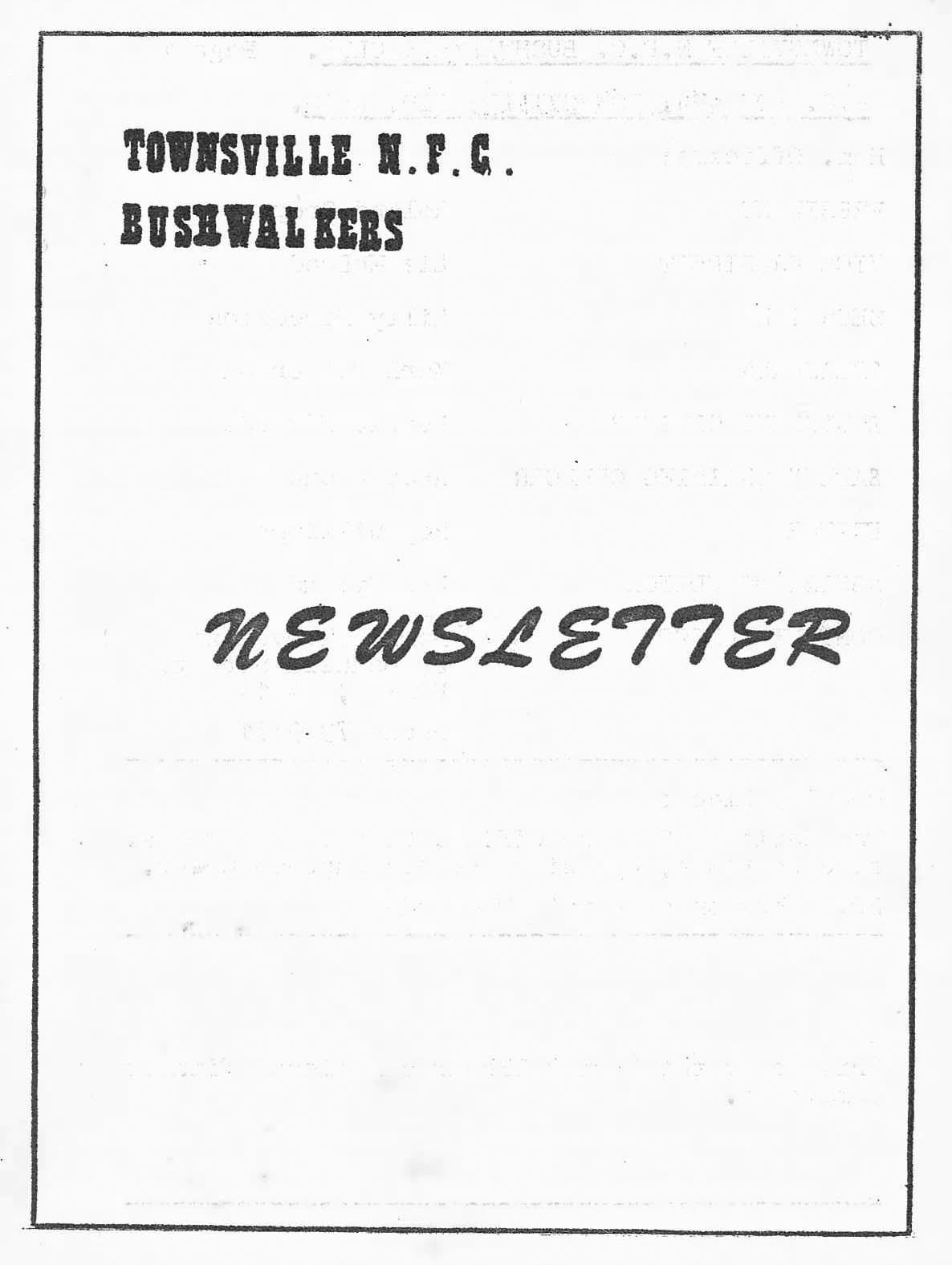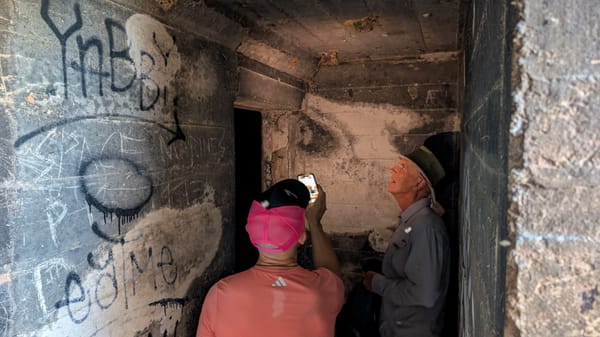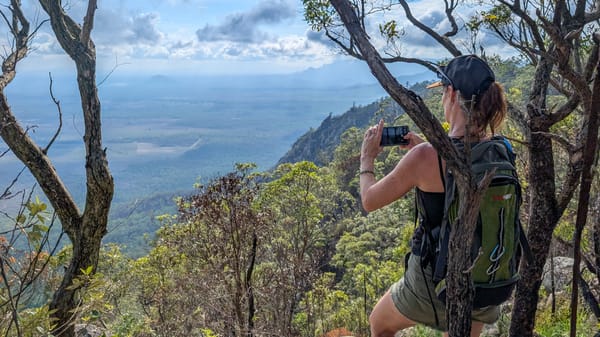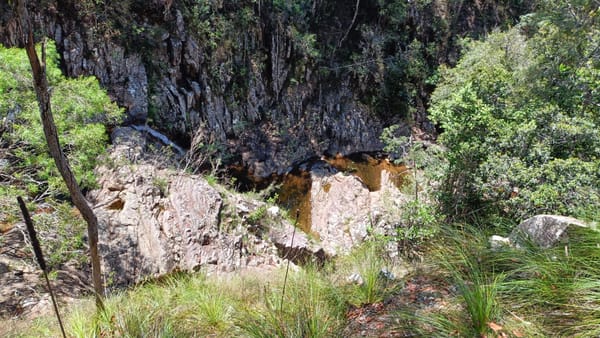TNFC Newsletter - May 1976
Explore the Townsville N.F.C. Bushwalkers 1976 newsletter featuring trip reports, hiking safety tips, and adventures from Mt Elliot to Alligator Creek Falls. Discover historic bushwalking events, training advice, and the spirit of North Queensland outdoor exploration.

TOWNSVILLE N.F.C. BUSHWALKERS NEWSLETTER
TOWNSVILLE N.F.C. BUSHWALKERS CLUB.
P.O. BOX 494, TOWNSVILLE, QLD. 4810.
Hon. Officers:
PRESIDENT Roland Gregory
VICE PRESIDENT Liz McLeod
SECRETARY Lilly Marcellos
TREASURER Mark Patterson
EQUIPMENT OFFICER Debbie Edwards
SAFETY TRAINING OFFICER Andy Plunkett
EDITOR Roy Williams
ASSISTANT EDITOR Les Hyland
CONTACT OFFICER Marion Darvenezia
22 Banksia Street,
Kirwin; 4814
Phone 79 9371
Meeting Place:
The National Fitness Office, Cleveland Terrace.
side entrance, opposite the old Supreme Court.
20.00 hrs on alternate Wednesdays
Printer by the Townsville Area National Fitness
Committee.
TRIP PROGRAMME, MAY - SEPTEMBER, 1976.
(Subject to change without notice.)
May 30th. D Mt. Elliot A.Simet
Jun. 12-14th. 3D Massey Gorge R. Williams
June 26-27th. WE Mt. Dryandra R. Williams
Jul. 10-11th. WE Basalt Wall L. Marcellos
Jul. 25th. D Cape Cleveland L. Murray.
Aug. 7-8th WE Keelbottom R. D. Edwards
Aug. 22nd. D Frederick Peak. L. Hyland
Sep. 4-5th. WE Tully Gorge L. Darveniza
Sep. 19th. D Mingela Caves L. McLeod.
****** Trip Times To be advised at meeting when arrangements are completed.
GENERAL MEETINGS
12.5.76
9.6.76
7.7.76
4.8.76
1.9.76
29.9.76
SOCIAL MEETINGS
26.5.76
23.6.76
21.7.76
18.8.76
15.9.76
13.10.76
"SAFETY SUGGESTION" by Andy Plunkett Page 3
Due to a recent minor search for an overdue walker I am submitting these points below which, if followed, should assist you insuch a situation.
There are certain natural rules apply to most rough and mountainous coutry; learn these, use you common sence and you will never really be "lost." A bushwalker should never be "lost" but he may be overdue.
Do's and Don'ts if "lost"
- DON'T PANIC. Sit down and think, Chew something to fade the empty feeling in the stomach.
- Appoint a leader, if you have not already got one; his decision to hold at all times.
- Mark a spot on realising that you are astray. Leave one man if you decide to scout around.
- Notice the time - estimate how long you have been astray and how far you can go before dark. If possible retrace your steps to the last landmark.
- Decide what direction you are going to take and stick to it. Pick definite landmarks and aim for them - don't beat about the bush (map and compass will help in this case)
- Make for the creeks or keep to the ridges. These lead down and eventually out.
- When changing direction leave prominent marks or notes (dated & timed). Break twigs, leave footprints etc. as you move.
- Walk steadily, rest ten minutes in each hour.
- Don't, if necessary, walk at night - accidents often happen at night. Build a big fire and make yourself comfortable.
- Never leave your pack, as if left it can not always be found.
- Never leave an injured person alone.
- Pool all rations; if short, use sparingly and cook carefully.
- Flash planes only if position is desperate.
- The accepted signal of distress is 3 cooees, 3 haybobs, 3 fires, 3 columns etc.
As a private mental exercise - think of all the items which would be (a) essential and (b) advantageous in carrying out the procedures detailed above. Then think how many of them YOU carry regularly when you go walking.
- LH.
TRIP REPORT.
Alligator Creek Falls; 04 APR. '76 By Les Hyland.
The night of April 3rd. is rained. This did not greatly set it apart from any other night in the extraordinarily atypical steaming summer of 75/76, but the result was notable - there was water in them there creeks on the Mt. Elliott Range. Leader Alan having designated the start as 07.00 on Sunday 4th. was busy waiting for late comers at 07.30 at the old courthouse. He was still waiting for latecomers at 08.45, but was then 42 km south at St. Margaret Creek. Eventually 19 intrepids followed him into a reedy jungle through a barbed wire fence and along the south side of the creek.
We seem to have spent sometime hopping back and forth over a barbed wire fence or two. Debbie's pack began unstrung in the process and much chivalry was shown at the "under & overs". A right turn and a deep paddle across the creek and we were following the power line, a really magnificent guideline despite its visual pollution or whatever Graeme called it. Creeks were forded mainly dry-shod, until we got fed up and sploshed through..........All except Marye that is ! Talk about being carried across the threshold...
We climber a gate and followed a path, at times almost indiscernable, through a few more creeks in accordance with Alan's "Mt Elliot Special" map. Suddenly, as Roy was very enthusiastically out front, we stopped and cut across a bush area to reach Alligator Creek. We could see the falls magnificent ahead but it took some Rock-hopping, tree-climbing and bank-slithering to reach the pools at their foot. By now two members of the party had stopped, but the rest struggled to the lunch stop and the pool was soon agitated by more that the Cascade. Member-ship of the "A" (for Alligator) club was conferred on those who could sit on the ledge under the waterfall. A comfortable seat until one realised that the water was quite capriciously endeavouring as you sat to remove the lower part of ones bikini or whatever!
After lunch a group scaled the face, and later on a second group did likewise. Meanwhile Andy found the slippery slide. It was exciting to ride on ones posterior some 50ft down a water shute and the participant's lenght and techniques improved up to the "twosome" stage before abahdonment of the project. The return by the same route was uneventful. That is if you discount the rainshower, the slow and fast parties, Andy's embarkation on a lilo in St. Margaret and Roy (at the time far in the lead) not making a left turn. A Splendid day.
"IN SEARCH OF A YETI" by Ron Ninnis.
I never came across a yeti in the foothills of the himlayas, but I did meet the unsophisticated, simple Nepali people. Nepal has been little influenced by Western culture. Unlike most Asian cpuntries, the Nepalis treat you as an equal. You always feel secure in their company and you could leave an expensive camera on a kitchen table and come to collect it a day later.
There are no symbols of Western civilisation's progress - no mod. cons. no mechanisation. The villagers work on very steeply terrassed land subsisting by cultivating rice, maize and lentils. Building materials are carted by man power - on the back. Shoulder straps are not used, only a single strap passing over the shoulders and round the forehead. It is common to see women struggling with huge loads of firewood.
From Kathmandu, the capital of the kingdom, I caught a rickety bus to Pokhara (This is a story in itself). From the 4km long Bazaar, I looked up to see what has been described as the world's most beautiful and sacred mountain,- Machapuchare, shaped like a fish tail.
In 14 days trekking, I spent a day at Gorepani, some 20 km distant from annapurna and then returned the way I had come. I had planned on only 7 days, but it was the wet season (this in July) and the tracks were really waterfalls. The track is, however, well trodden by Hindu pilgrims travelling to Mukunath. There are many "chai" stops and hostels along the road giving a free bed (often a mat on the floor) is you bought food. Usually the main dish was rice with a side-dish of curried lentils and potatoes.
Women are still unliberated here. The women wait until all the men have eaten before they will eat themselves. Marriage is still arranged by parents and the women's work is as hard as the men's. It is a difficult life for both but the people are strong. The famous Gurka soldiers came from particular castes in this area.... I was sad to leave.
DYRANDER ROCK CARVINGS by Rick Williams
Shades of ancient Baggalas rounding the Australian Coast; Carvings resembling those on the great obelisk at Alenadria; Dolls belonging to the children of the aristocracy of Egypt; Phantoms of the Past, or figments of an over - expanded imagination. For anyone following the reported rediscovery of alleged rock carvings on the summit of central Queensland higher mountains imagination can truly run riot with the many possibilities. One thing the writer can justly be blamed for (it's part of the tragedy of being born in the deep North) is the ability to make the tale better with the telling. Since my guess is good as anyone else's let me here sound a few hypotheses founded on assumption that the carvings are real and an add pattern of rock shattering brought about by natural causes.
Firstly Australian was by no means a discovery of Cook, or the Dutch before him, or any other European explorer. When Flinders arrived at the Arnhem Land coast around 1800 he sighted half a dozen prows, trading boats from Macassar gathering "Bechede-Mer". Macassar was a trading post for the Spice Islands century's beofre Cook and, by chain of knowledge - that is knowledge passed through ports, countrys and language barriers - some knowledge of such places as the North land existed in folk lore long before recorded history.
Marco Polo was not believed in 1925 in his reports of advanced trading nations (Cathay in particular) in the far east. Polo actually travelled as far south as Palembanf in Sumatra and to Java. It is not beyond possibility that in fertile crescent Mesopotamia to Egypt, an advanced trading network existed about the time of Ur. of the Chaldees predating Solomon, who was an established trader to the lands south of the Red Sea. I suggest a date as early as 6000 BC.
Secondly, Assuming legitimate work of artisans it is inconcievable that aborigines, a Stone Age people, could carv in rock with out metal iron or bronze. To my knowledge the hardest flint ax will not mark Diorite although Aborigines were known to carve in softer rock ss sandstone.
The third part of this hypothesis is somewhat of a puzzle. Why would anyone carve on rocks on the top of a jungle clad hill. The coast line of Australia was stable, in fact much as it is today so no upthrust is invelved, A possible answer is that the carivngs were not done on a jungle clad hill. In the interval of several thoudans years climatic variations have probably taken place to a greater or lesser extent along the coast. The valleys undoubtedly held rain forest but the in question may well have been bald with prominent rock facings on which carvings could be made that would be visible from the sea, assuming that they face in that direction. Mt. Roundback North of Bowen and example is a 2000 ft mountain in the 40 in rain fall belt. It is covered with stunted open forest and bold rock extrusions but certainly not rain forest.
In conclusion and againusing someone elses assumptions, the Egyptians knew of the Boomerang and, according to Mr Muller had a mummified animal resempling a kangaroo or wallaby enclosed in one of their tombs.
Getting back to reality, let's just go and have a look at the rock..........
-o-O-o-
A BRIEF WORD OF QUARANTINE by Roy Williams
The function of the Australian Quarantine Service is to prevent the entry of any human, plant or animal diseases from other parts of the world. Many of these diseases are common to most parts of the world, and we are fortunate that none of them have been able to take hold here. This was possible in the past because of our Geographical position, but now with the advent of fast air travel, the risk has become much greater.
A look at some of the more commonly known diseases will explain the dangers further;-
In the field of human disease some of the most widely known are; smallpox, cholera, plague, yellow fever, etc. All of these can be killers and all are endemic in other parts of the world. They can be transmitted by various and different means some of which are;- food and drink; by insects such as mosquitoes or fleas; or by merely breathing in contaminated spores in the air. As the majority of the Australian population are not regularly vaccinated against any of these then an introduction could cause a serious epidemic in a very short time.
With diseases of animals probably the most widely known would be foot and mouth disease and rabies. Foot and mouth disease has cost the cattle and dairy industries of the world millions of dollars as the usual action taken to prevent the spread of the disease is to destroy infected beasts. The disease is confined to ruminant animals such as cattle, sheep and pigs, but can be transmitted by various means such as animal products, contaminated clothing, fodder or even in soil. Rabies, usually associated with dogs, but can be transmitted with fatal results to humans. is another disease closely policed.
These can take the form of viruses, fungii, nemetodes, insects, parasites. These officers also police the transfer of various plants inter-state also are area within Australia itself which are infected by diseases unknown in other states. One of these which entered Australia in the last century: PHYLOXERA VITIFOLEA or vine louse completely destroyed the grapegrowing industry in N.S.W. and Victoria. Another, the Sirex wood wasp, has been responsible for the destruction of thousands of acres of pine forests in Victoria and Tasmania.
-o-O-o-
ON THE LIGHTER SIDE:
Remember a crocodile won't attack you if you carry a torch. The trick is to carry it faster that the "croc" can run.
-o-O-o-
Contributors wanted for next issue. How about you?
-o-O-o-




